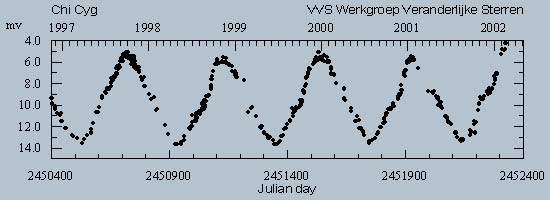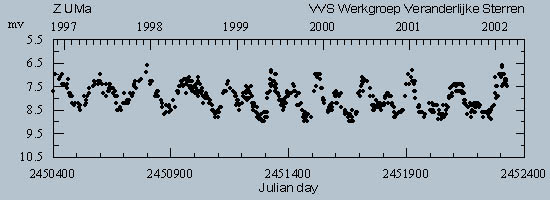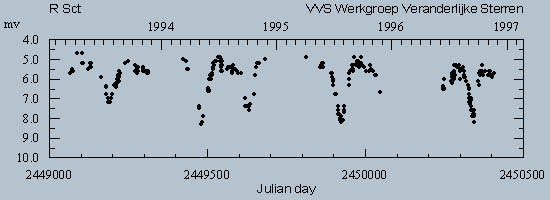Pulsating variables are stars showing periodic expansion and contraction of their surface layers.
The pulsations may be radial or nonradial. A radially pulsating star remains spherical in shape, while in the
case of nonradial pulsations the star's shape periodically deviates from a sphere, and even neighbouring
zones of its surface may have opposite pulsation phases.
Our observing programme contains the following sub-types :
Mira stars (M)
Mira (Omicron) Ceti-type variables. These are long-period variable giants with characteristic late-type emission spectra (Me, Ce, Se) and light amplitudes from 2.5 to 11 mag in V. Their periodicity is well pronounced, and the periods lie in the range between 80 and 1000 days. Infrared amplitudes are usually less than in the visible and may be <2.5 mag. For example, in the K band they usually do not exceed 0.9 mag. If the amplitudes exceed 1 - 1.5 mag , but it is not certain that the true light amplitude exceeds 2.5 mag, the symbol "M" is followed by a colon, or the star is attributed to the semiregular class with a colon following the symbol for that type (SR).

Semi-regular variables (SR)
These giants or supergiants of intermediate and late spectral types show noticeable periodicity in their light changes, accompanied or sometimes interrupted by various irregularities. Periods lie in the range from 20 to >2000 days, while the shapes of the light curves are rather different and variable, and the amplitudes may be from several hundredths to several magnitudes (usually 1-2 mag in V). They are divided into four sub-types : SRa, SRb, SRc and SRd.

RV Tauri stars
These are radially pulsating supergiants having spectral types F-G at maximum light and K-M at minimum. The light curves are characterized by the presence of double waves with alternating primary and secondary minima that can vary in depth so that primary minima may become secondary and vice versa. The complete light amplitude may reach 3-4 mag in V. Periods between two adjacent primary minima (usually called formal periods) lie in the range 30-150 days. Lightcurves show alternating deep and shallow minima.
